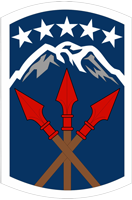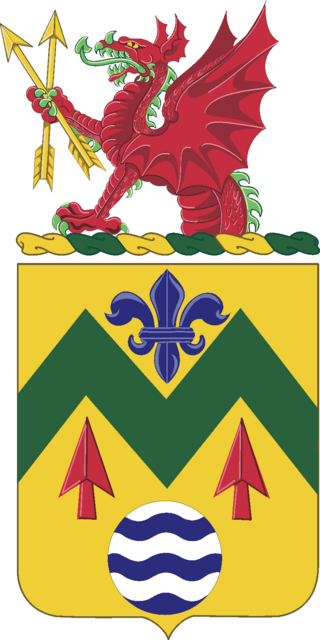
A battalion is a military unit, typically consisting of 300 to 1,000 soldiers commanded by a lieutenant colonel, and subdivided into a number of companies. The typical battalion is built from three operational companies, one weapons company and one HQ company. In some countries, battalions are exclusively infantry, while in others battalions are unit-level organisations.

A regiment is a military unit. Its role and size varies markedly, depending on the country, service, or specialisation.

A brigade is a major tactical military formation that typically comprises three to six battalions plus supporting elements. It is roughly equivalent to an enlarged or reinforced regiment. Two or more brigades may constitute a division.

The Royal New Zealand Army Logistic Regiment, is the New Zealand Army's main military Logistics and combat service support (CSS) element. It is the largest regiment in the NZ Army.

The United States Army Quartermaster Corps, formerly the Quartermaster Department, is a sustainment and former combat service support (CSS) branch of the United States Army. It is also one of three U.S. Army logistics branches, the others being the Transportation Corps and the Ordnance Corps.
Combat service support is a topic that is, broadly speaking, a subset of military logistics. However, combat service support is often more limited in depth, as the related groups primarily address factors supporting readiness for combat operations. The United States Department of Defense organizes various agencies providing services such as medical assistance, for example, akin to other nations' militaries.

The 3rd Marine Logistics Group is the Logistics Combat Element (LCE) for III Marine Expeditionary Force currently headquartered on Camp Kinser, Marine Corps Base Smedley D. Butler, Okinawa, Japan. 3rd MLG provides combat service support (CSS) to III MEF units above the organic capability. CSS is the essential capabilities, functions, activities, and tasks necessary to sustain all elements of operating forces in theater at all levels of war. Combat service support includes, but is not limited, to supply, maintenance, transportation, general engineering, health services, and other services required by aviation and ground combat forces to permit those units to accomplish their missions.
In the United States Marine Corps, a Marine Air–Ground Task Force is the principal organization for all missions across the range of military operations. MAGTFs are a balanced air–ground, combined arms task organization of Marine Corps forces under a single commander that is structured to accomplish a specific mission. The MAGTF was formalized by the publishing of Marine Corps Order 3120.3 in December 1963, "The Marine Corps in the National Defense, MCDP 1-0". It stated:
A Marine air–ground task force with separate air ground headquarters is normally formed for combat operations and training exercises in which substantial combat forces of both Marine aviation and Marine ground units are included in the task organization of participating Marine forces.
A regimental combat team (RCT) is a provisional major infantry unit which has seen use by branches of the United States Armed Forces. It is formed by augmenting a regular infantry regiment with smaller combat, combat support and combat service support units.

The 13th Armored Corps Sustainment Command—the "Lucky 13th"—is a U.S. Army modular sustainment command which serves as a forward presence for expeditionary operations for a theater, or in support of a regional combatant commander. Corps Sustainment Commands (CSC), such as the 13th, synchronize distribution of supplies and services within their operational areas and provides distribution oversight. Formed at Fort Cavazos, Texas when the 1st Logistics Command deployed to Vietnam, the organization then known as the 13th Support Brigade was initially responsible for the training of technical services units to assume combat service support missions in Southeast Asia.

Combat Logistics Battalion 2 (CLB-2) is a logistics unit of the United States Marine Corps (USMC), which provides direct combat service support to Regimental Combat Team 2 (RCT-2). CLB-2 was formed after its second deployment to Iraq in 2005 as a part of the reorganization of the 2nd Force Service Support Group. The battalion falls under Combat Logistics Regiment 2 and the 2nd Marine Logistics Group and is headquartered at Marine Corps Base Camp Lejeune, North Carolina in the USA.
In the United States Army, the term combat support refers to units that provide fire support and operational assistance to combat elements. Combat support units provide specialized support functions to combat units in the following areas

The Albanian Support Command is a supporting command of the Albanian Armed Forces, which has as its primary mission the support of the Armed Forces in the areas of procurement and supply, maintenance, transport, inventory, medical supply, and supporting civil-military cooperation for these issues. The Support Command and logistic support units of the AAF should be able to accomplish all requirements to enable logistics sustainment of force operations in every kind of environment.

The 16th Sustainment Brigade is a sustainment brigade of the United States Army based at Smith Barracks in Baumholder, Germany. It is a subordinate unit of the 21st Theater Sustainment Command of the Seventh Army.

The 593rd Expeditionary Sustainment Command is a Sustainment Command of the United States Army.

The 528th Support Battalion is a battalion of the United States Army. The 528th Support Battalion's mission is to provide rapidly deployable CSS and HSS to ARSOF as directed. The 528th Support Battalion's strengths lie in its capability to support ARSOF-unique and low-density weapons and vehicles. The 528th complements [organic] 22 ARSOF CSS, HSS, and signal units. The support battalion consists of a headquarters and main support company (HMSC), three forward support companies and may receive augmentation from Theater Army. As part of Army Special Operations Command the unit, along with the 112th Signal Battalion, is tasked to provide full logistical support to Army Special Operations Forces forming along with several other units what was known as Special Operations Support Command, later reorganized as the 528th Sustainment Brigade (A). The Brigade Troops Battalion includes a wide variety of military occupation specialists: riggers, drivers, medics, mechanics, engineers, fuelers, cooks, etc.
13th Combat Sustainment Support Battalion is a modular, corps-level support organization Battalion responsible for providing multifunctional logistics support to maneuver, fires, and effects organizations as well as multifunctional logistics assistance to other support organizations. The 13th CSSB was formerly stationed at Fort Benning, Georgia, and was a subordinate unit of the 3rd Sustainment Brigade. The battalion was deactivated in October 2011 at Ft Benning and reflagged from the former 80th Ordnance Battalion at Joint Base Lewis/McChord. The battalion is now subordinate to the 593rd Expeditionary Sustainment Command.

The 3rd Expeditionary Sustainment Command is a United States Army unit. It derives its lineage from the 3rd Logistical Command, which was activated in Japan on 19 September 1950 for service in Korea.
142nd Division Sustainment Support Battalion is a multifunctional logistics headquarters. It is task organized as a Division Sustainment Support Battalion with capability required to support specified mission requirements. The CSSB supports echelon above brigade units, multifunctional brigades, functional support brigades, and brigade combat teams. The 142nd DSSB is currently stationed at Fort Bliss, Texas, and is a subordinate unit of the 1st Armored Division Sustainment Brigade.
Future Soldier is a reform of the British Army resulting from the Integrated Review of Security, Defence, Development and Foreign Policy published in March 2021. The aim of the reform is to create a more lethal, agile and expeditionary force, able to fight and win wars and to operate in the grey-zone between peace and war. Future Soldier was published on 25 November 2021 and deals with the organizational changes of the British Army, with changes to personnel and equipment were set out in the Defence in a Competitive Age paper published on 22 March 2021.













